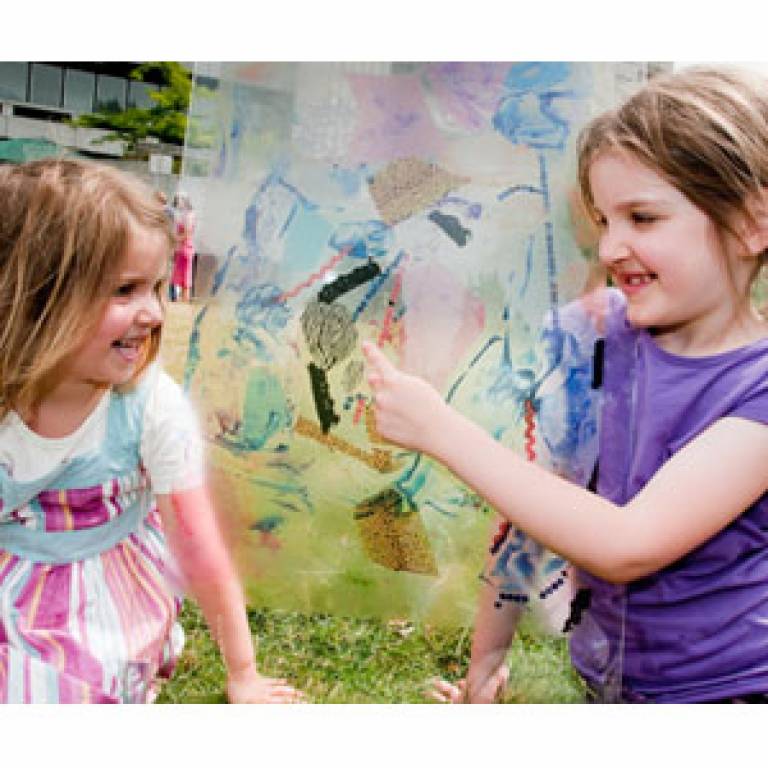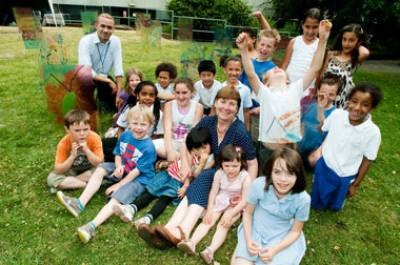Life under UCL microscope inspires schoolchildren's art
2 August 2010
Links
 ucl.ac.uk/iris/browse/profile?upi=TDMCH80" target="_self">Dr Timothy McHugh
ucl.ac.uk/iris/browse/profile?upi=TDMCH80" target="_self">Dr Timothy McHugh
Schoolchildren were inspired by tiny microbes they'd seen in a UCL lab to create artwork on display in the grounds of the Royal Free hospital.
The youngsters aged five to 10 created an array of colours, shapes and patterns after seeing bacteria and fungi under a microscope at their school and during a visit to the UCL laboratory.
The children's collages were printed onto 20 giant 'laboratory slides' made of perspex and displayed in the Royal Free's Heath Strange Garden.
The science and education project involved the Royal Free, UCL and South Haringay Junior School, and was funded by the Wellcome Trust. Parents took part in the project as part of the school's Family Learning Group, which encourages families to become active in their children's learning.
Cheryl James, a community artist who came up with the idea for the project, said: "It got the children finding out about microbiology in a fun and creative way.
"In the lab, the children took swabs from their mouths and looked at the microbes under a microscope. It's helped them and their parents understand how science is all around us and at the same time they've created a bright and colourful artwork."
Cheryl's husband, Dr Ed James, a former microbiology consultant at the Royal Free, said: "Microbes get a bad press. Everyone thinks of MRSA or bird flu, but there are many "friendly" viruses and bugs.

"We wanted children and their parents to explore the world of microbes in a positive way. Everyone has microbes on and in their body. We wouldn't exist without them and the vast majority don't cause disease."
Dr Tim McHugh (UCL Infection and Immunity) said: "When Cheryl James proposed this initiative we were pleased to help out as it provided an innovative way to introduce children and their parents to the world of microbiology. We were pleased to have an opportunity to share our fascination with the micro-organisms that inhabit us and our environment. We hope that the children have had a glimpse of the important, exciting and beautiful world of microbiology."
Schoolgirl Iona Imlah, aged seven, said: "It was fun going to the lab and drawing all the patterns we saw. It's good to know what microbes look like."
Charlie Paulicic, aged nine, added: "It's a really fun way to learn about germs."
The children and their parents visited Heath Strange Garden this week to have a picnic and see their colourful creations on show. The artwork will be returned to the junior school.
Image above left: Iona Imlah, aged seven, explains her 'microbe' art to her sister Mary
Image above right: Community artist Cheryl James, centre, with Dr Emmanuel Way, a microbiologist, and children involved in the project.
UCL context
Research groups in the UCL Division of Infection and Immunity form part of either the Research Department of Immunology or the Research Department of Infection.
The Research Department of Infection was created this year to bring together the academic disciplines of Virology, Microbiology and Infectious Disease across UCL. The Department is within the Division of Infection and Immunity, facilitating collaboration with the Immunological specialties within the division. It also has close links with the affiliated Centre for Paediatric Infectious Diseases and Microbiology at the Institute of Child Health and The Eastman Centre for Microbial Infections at the Eastman Dental Hospital.
UCL is also a founding partner of Europe's largest academic
health science centre. UCL Partners, designated one of the UK's first
academic health science centres in March 2009 by the Department of
Health, comprises five of London's biggest and best-known hospitals and
research centres:
- UCL
- Great Ormond Street Hospital for Children NHS Trust
- Moorfields Eye Hospital NHS Foundation Trust
- the Royal Free Hampstead NHS Trust and
- University College London Hospitals NHS Foundation Trust (UCLH).
Together they will conduct cutting-edge research into infectious diseases; neurological disorders; eyes and vision; child health; women's health; and immunology and transplantation.
 Close
Close

